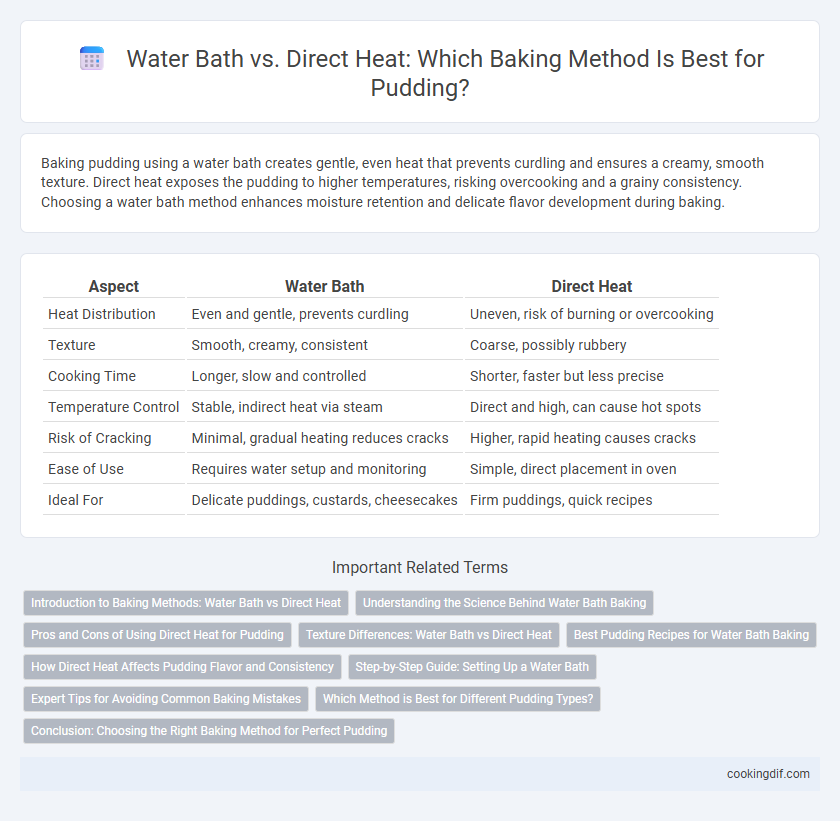Baking pudding using a water bath creates gentle, even heat that prevents curdling and ensures a creamy, smooth texture. Direct heat exposes the pudding to higher temperatures, risking overcooking and a grainy consistency. Choosing a water bath method enhances moisture retention and delicate flavor development during baking.
Table of Comparison
| Aspect | Water Bath | Direct Heat |
|---|---|---|
| Heat Distribution | Even and gentle, prevents curdling | Uneven, risk of burning or overcooking |
| Texture | Smooth, creamy, consistent | Coarse, possibly rubbery |
| Cooking Time | Longer, slow and controlled | Shorter, faster but less precise |
| Temperature Control | Stable, indirect heat via steam | Direct and high, can cause hot spots |
| Risk of Cracking | Minimal, gradual heating reduces cracks | Higher, rapid heating causes cracks |
| Ease of Use | Requires water setup and monitoring | Simple, direct placement in oven |
| Ideal For | Delicate puddings, custards, cheesecakes | Firm puddings, quick recipes |
Introduction to Baking Methods: Water Bath vs Direct Heat
Water bath baking provides gentle, even heat by surrounding the pudding mold with hot water, preventing curdling and ensuring a smooth, creamy texture. Direct heat exposes the pudding directly to the oven's heat, which can cause uneven cooking and cracked surfaces. Choosing the right method impacts the pudding's consistency, moisture retention, and final presentation quality.
Understanding the Science Behind Water Bath Baking
Water bath baking creates a gentle, consistent heat environment by surrounding the pudding with hot water, preventing the edges from cooking faster than the center and reducing the risk of curdling or cracking. Direct heat exposes the pudding to uneven, high temperatures that can cause overcooking, resulting in a grainy texture or burnt edges. The science behind water bath baking lies in heat transfer and temperature regulation, allowing delicate custards to set evenly by maintaining a temperature around water's boiling point (100degC or 212degF).
Pros and Cons of Using Direct Heat for Pudding
Using direct heat for baking pudding allows for quicker cooking times and a more pronounced caramelized crust but increases the risk of uneven heat distribution leading to overcooked edges or curdled texture. This method lacks the gentle, consistent warmth provided by a water bath, which can result in a less smooth and creamy pudding consistency. Direct heat requires careful monitoring to prevent scorching or burning, making it less forgiving than the water bath technique.
Texture Differences: Water Bath vs Direct Heat
Using a water bath for baking pudding creates a gentle, even heat that prevents curdling and results in a smooth, creamy texture. Direct heat exposes the pudding to higher, uneven temperatures, often causing a firmer, sometimes rubbery consistency with potential cracking. The water bath method preserves moisture and tenderness, making it ideal for delicate custard-based puddings.
Best Pudding Recipes for Water Bath Baking
Water bath baking ensures even heat distribution, producing creamy and smooth puddings without curdling or cracking. This method maintains gentle, consistent temperatures ideal for delicate custard-based puddings like creme caramel or flan. Direct heat can cause uneven cooking and a grainy texture, making water bath the preferred choice for the best pudding recipes.
How Direct Heat Affects Pudding Flavor and Consistency
Direct heat baking intensifies pudding flavor by encouraging caramelization of sugars on the surface, resulting in a richer, slightly toasted taste. This method often produces a denser, firmer texture due to faster coagulation of eggs and proteins, which can lead to a less creamy consistency compared to water bath baking. Careful temperature control is essential with direct heat to prevent curdling and maintain a balanced flavor profile.
Step-by-Step Guide: Setting Up a Water Bath
Setting up a water bath for pudding baking begins by preheating the oven to the recipe-specified temperature, ensuring even heat distribution. Place the pudding mold into a larger baking pan and carefully pour hot water around the mold, filling until it reaches halfway up the sides to prevent cracking and promote gentle, uniform cooking. Cover the pudding with foil or a lid to retain moisture and bake until the center is set and the texture is smooth, which preserves the creamy consistency unique to water bath method compared to direct heat.
Expert Tips for Avoiding Common Baking Mistakes
Using a water bath (bain-marie) for baking pudding ensures even heat distribution, preventing curdling and overcooking by maintaining gentle, consistent temperatures. Avoid direct heat when baking custard-based puddings, as it can cause texture issues like cracking and graininess due to uneven, intense heat exposure. Experts recommend tightly sealing the pudding dish with foil during water bath baking to retain moisture and achieve a smooth, creamy consistency.
Which Method is Best for Different Pudding Types?
Water bath baking provides gentle, even heat ideal for delicate puddings like custards and cheesecakes, preventing cracking and curdling by maintaining a controlled temperature. Direct heat suits denser, more robust puddings such as bread or rice pudding, where a firmer texture is desired and moisture retention is less critical. Selecting the best method depends on pudding type: creamy, silky textures benefit from water baths, while hearty, baked puddings perform well under direct heat.
Conclusion: Choosing the Right Baking Method for Perfect Pudding
A water bath provides gentle, even heat that prevents pudding from curdling or cracking, ensuring a smooth and creamy texture. Direct heat can cause uneven cooking and risk overcooking the edges while leaving the center underdone, impacting the pudding's consistency. For perfect pudding, the water bath is the optimal baking method, promoting uniform heat distribution and delicate custard development.
Water Bath vs Direct Heat for baking method Infographic

 cookingdif.com
cookingdif.com